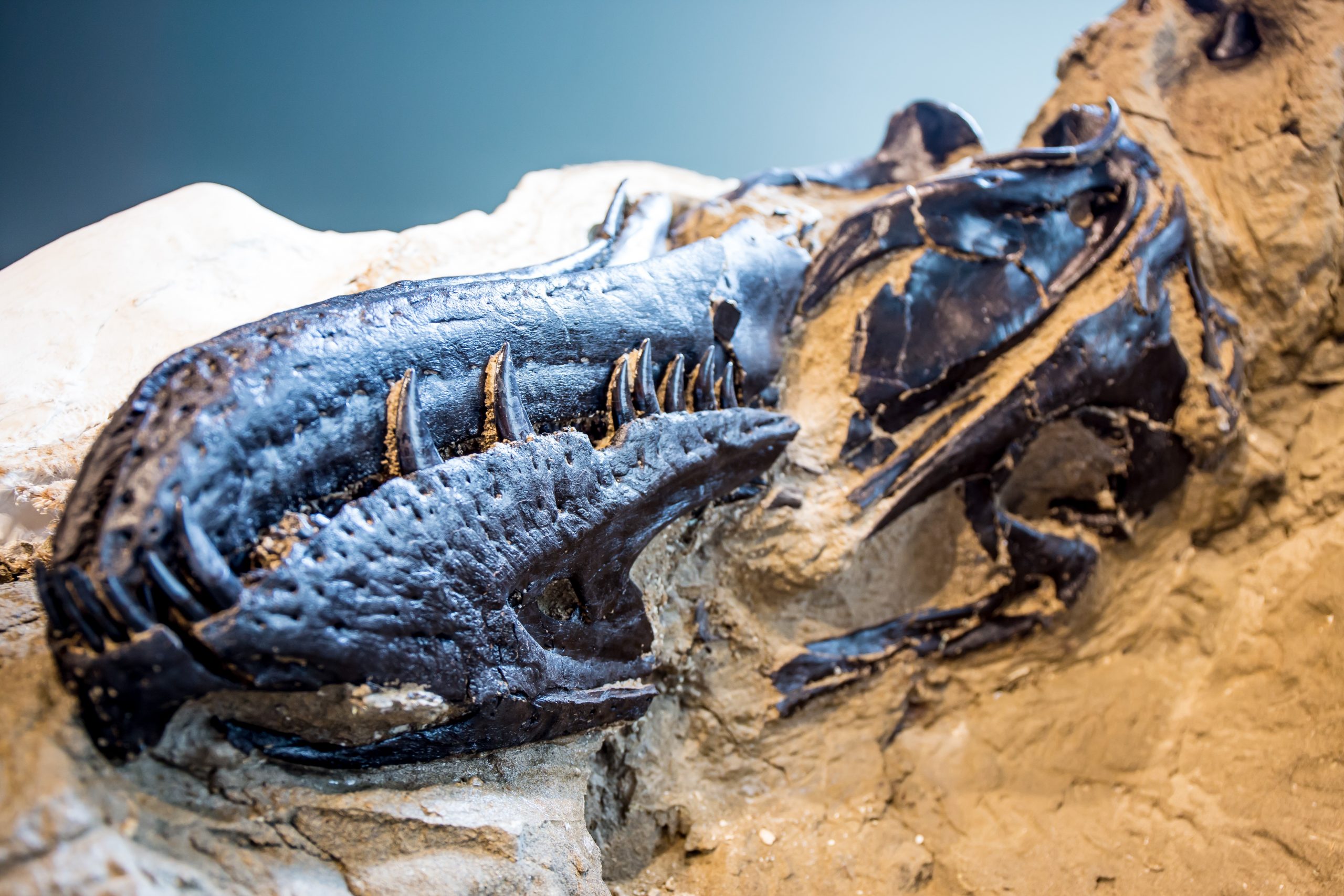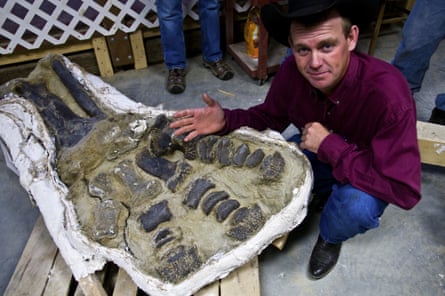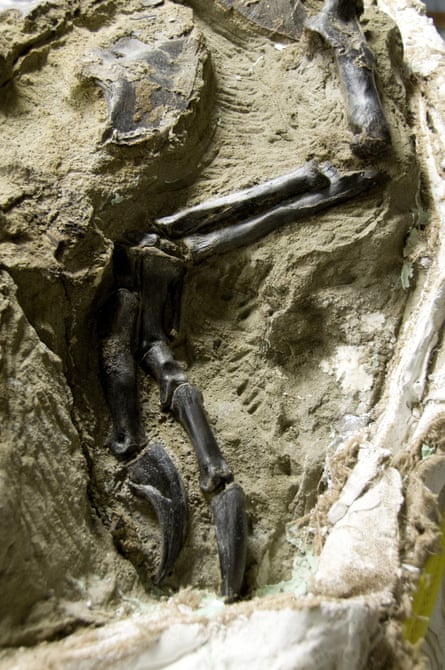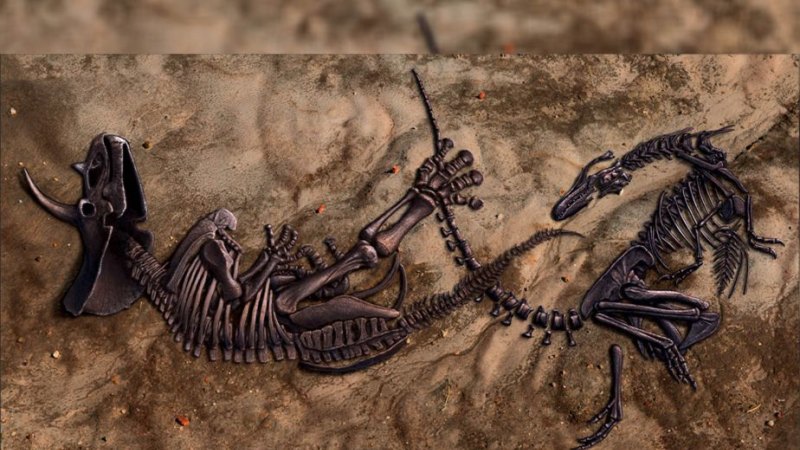Perhaps the best dinosaur fossil ever discovered. So why has hardly anyone seen it?
A Montana rancher found two skeletons in combat – the Dueling Dinosaurs. But who do they belong to, and will the public ever see them?
The early June morning in Montana was already very hot and dry by 7.30, when Clayton Phipps and his friend, Mark Eatman, set out to search for fossils. Phipps, a rancher who calls himself the Dino Cowboy, was wearing his trademark black felt Stetson cattleman hat.
The two had gone bone collecting before, but they were joined on this day for the first time by Phipps’s cousin, Chad O’Connor. The trio fanned out to hike through the badlands of what they thought was the Judith River Formation; later, they would learn they had actually been in an area called Hell Creek, a division of gray and ochre sandstone, shale and clay deposited about 66m years ago during the Late Cretaceous, when the area was a swampy floodplain.
Phipps, like most locals, calls it the Hell Crik. It’s one of the most storied dinosaur fossil sites in the world.

At lunchtime, the group reconvened for roast beef sandwiches. Phipps asked Eatman if he had found anything. Yes, he said, a pelvis weathering out of a hill – not a big deal, except this one appeared to have an articulated femur, potentially suggesting a rare level of completeness. They went to the site. Phipps could tell right away it was from a ceratopsian, a group of herbivorous, beaked dinosaurs. He brushed away some of the sand, and thought there might be more of the dinosaur buried in the hillside.
But excavating it would have to wait for another day: he had 260 acres of hay to cut for cattle feed.
Eatman went back to Billings, where he had gotten a job at a carpet store after a run of bad luck put an end to his 13-year career as a full-time fossil hunter. (“His wife said: ‘We’re starving to death – you gotta get a real job,’” Phipps recalls.)
O’Connor and Phipps headed home to Phipps’s ranch. “We weren’t all that excited,” he says. “It was a pelvis in the ground at the bottom of a canyon that was really remote and no roads to it at all. We had no plans to go back, but Chad convinced us to. I’m sure glad we did.”

The site in Montana is one of the most storied dinosaur fossil sites in the world. Photograph: Clayton Phillips
After two weeks, the body of the plant-eater had been revealed. It was more than a pelvis and femur – it looked like a fairly complete skeleton of Triceratops horridus, which is the triceratops you’re thinking of. One day, Phipps was behind the wheel of his uncle’s backhoe, scooping out soil from around the fossil so it could be removed. Carefully watching each dump of the bucket, at one point he noticed dark fragments among the light-colored sandstone.
Oh no, he thought. He jumped down, combed through the sand, found the claw of a theropod. Theropods, like Tyrannosaurus rex, are three-toed carnivores. That doesn’t match the plant-eater, Phipps thought. What is happening here?
This was in 2006. Three months of intensive excavation followed, during which Phipps lost 15 pounds. In the end, he and his partners had a 28ft-long ceratopsian and a 22ft-long theropod in four multi-ton blocks. “A little cowboy ingenuity, and we got ’em out of the hills,” Phipps says.

The number of people who have seen the fossils remains in the low double digits. Photograph: Peter Larson
The meat-eater was either a juvenile T rex or its relative, Nanotyrannus lancensis, a rare dwarf species whose existence is disputed. Both dinosaurs were extraordinarily well-preserved, fully articulated, with envelopes of skin and, possibly, mummified internal organs.
Phipps dubbed them the Montana Dueling Dinosaurs. “They’re remarkable specimens,” says Mark Norell, chairman of paleontology at the American Museum of Natural History. “Especially the tyrannosaur – it could go a long way toward resolving whether nanotyrannus was its own species.
“Dinosaurs bring drama,” Phipps says, “and being a cowboy, I’m not a drama fan. You can have it.”
They contacted natural history museums around the world, including the Smithsonian – where the bones were offered for a reported $15m – and the Museum of the Rockies, in Bozeman, Montana, whose then head paleontologist, Jack Horner (the inspiration for the character played by Sam Neill in Jurassic Park) told them they were scientifically useless.
“In order for a specimen to be of scientific use and publishable, we have to know its exact geographic position, its exact stratigraphic position, and the specimen must also be in the public trust, accessible for study, which this specimen is not,” Horner says.

The bones were offered to the Smithsonian for $15m. They didn’t sell. Photograph: Peter Larson
Phipps called Horner’s reaction “sad”, adding: “If somebody in his position is telling the world that the best dinosaurs possibly ever discovered in the world are worthless, what donor’s gonna donate anything to paleontology?”
Acrimony between commercial and academic paleontologists is abundant. “The haters are always gonna hate,” Phipps says. “No question about that.”

In the meantime, other valuable dinosaur fossils were found on the 27,000-acre Murray ranch, including a well-preserved triceratops skull and nearly complete adult T rex, which a Dutch museum purchased for several million dollars. The Dueling Dinosaurs themselves went to auction in 2013 at Bonhams in New York, but no bid met the reserve price of $6m.
Larson’s story is also one of loss. After the T rex known as “Sue” was discovered by Black Hills in 1990, a dispute arose over its legal ownership. Two years later, the bones were seized by the FBI and South Dakota national guard in a highly publicized case, and ownership was returned to the landowner, a Sioux rancher whose deed was held in trust by the Bureau of Indian Affairs. He sold Sue at auction for a record $8.36m to the Field Museum in Chicago. Subsequently, Larson was sentenced to two years in federal prison on separate charges related to trafficking fossils, including failing to report to customs traveler’s checks and cash transported internationally, and illegally taking a fossil worth less than $100 from federal land.
His experience with the legal morass around dinosaur fossils would prove useful later.
For 14 years, the Seversons and Murrays operated the ranch in amicable partnership. But in 2005, the Murrays purchased the other half of the land. Exactly why is unclear; the Seversons say Lige called to ask about buying them out, while Mary Ann says the Seversons approached them unexpectedly. An agreement was reached to split the estate: the Murrays would control all of the surface rights and one-third of the mineral rights, and the Seversons would retain the rest of the mineral rights.
The following summer, the Dueling Dinosaurs were found.
“Lige and I knew nothing about fossils,” Mary Ann Murray says. “We just ran cows and farms, that’s all we did.”

Last November, a court ruled that fossils on Montana state and private land could be considered minerals. Photograph: Peter Larson
The Seversons say they didn’t know the bones were worth much until 2013, when they were appraised between $7 and $9m before the auction. So they decided to assert a mineral rights claim after the Murrays refused to share any of the future proceeds. The following year, the Murrays filed a lawsuit seeking a declaratory judgment that the fossils were theirs because they owned the surface estate. A district court ruled in their favor, leading the Seversons to appeal to the US ninth circuit.
In a test, last November that court ruled that fossils on Montana state and private land could be considered minerals. “Once upon a time, in a place now known as Montana, dinosaurs roamed the land,” begins Judge Eduardo Robreno’s opinion. “On a fateful day, some 66m years ago, two such creatures, a 22ft-long theropod and a 28ft-long ceratopsian, engaged in mortal combat. While history has not recorded the circumstances surrounding this encounter, the remnants of these Cretaceous species, interlocked in combat, became entombed under a pile of sandstone. That was then … this is now.”
The decision sent shockwaves through the field of paleontology, jeopardizing as it did the status of any fossil found on private land in Montana. The Murrays filed for an en banc appeal, supported by an amicus curiae brief from paleontological institutions including the Field Museum, the Museum of the Rockies and the Society of Vertebrate Paleontology – which had opposed Larson in the Sue case.
